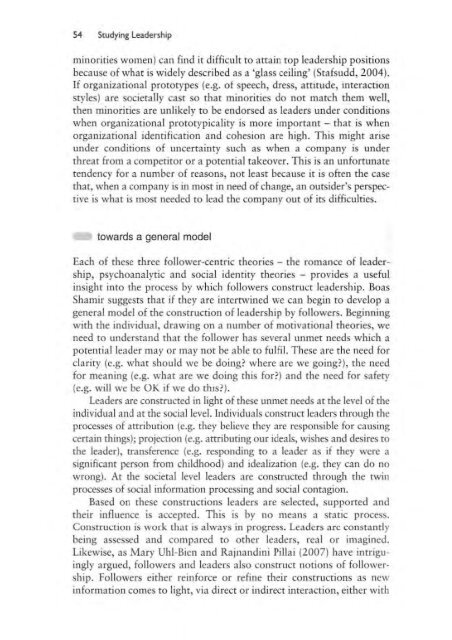Jackson Parry - Leadership, Chp 3, 41-60.pdf
Jackson Parry - Leadership, Chp 3, 41-60.pdf
Jackson Parry - Leadership, Chp 3, 41-60.pdf
- No tags were found...
Create successful ePaper yourself
Turn your PDF publications into a flip-book with our unique Google optimized e-Paper software.
54 Studying <strong>Leadership</strong>minorities women ) can find it difficult to attain top leadership positionsbecause of what is widely described as a 'glass ceiling' (Stafsudd, 2004).If organiza tional prototypes (e.g. of speech, dress, attitude, interactionstyles) are societally cast so that minorities do not match them well,then minorities are unlikely to be endorsed as leaders under conditionswhen organizational prototypicality is more important - that is whenorganizational identification and cohesion are high. This might ariseunder conditions of uncertainty such as when a company is underthreat from a competitor or a potential takeover. This is an unfortunatetendency for a number of reasons, not least because it is often the casethat, when a company is in most in need of change, an outsider's perspective is what is most needed to lead the company out of its difficulties.lowards a general modelEach of these three follower-centric theories - the romance of leadership,psychoanalytic and social identity theories - provides a usefulinsight into the process by which followers construct leadership. BoasShamir suggests that if they are intertwined ,ve can begin to develop ageneral model of the construction of leadership by fo llowers. Beginningwith the individ ual, drawing on a number of motiva tional theories, weneed to understand that the follower has severa l unmet needs which apotential leader ma yor may not be able to fulfil. These are the need forclarity (c.g. what should we be doing? where are we going?), the needfor meaning (e.g. what are we doing this fo r?) and the need fo r safety(e.g. will we be OK if we do thIS?).Leaders are constructed in light of these unmet needs at the level of theindividua l and at the social level. Individuals construct leaders through theprocesses of attribution (e.g. they believe they are responsible for causingcertain th ings); projection (e.g. attributing our ideals, wishes and desires tothe leader), transference (e.g. responding to a leader as if they were asignificant person fro m childhood) and idealization (e.g. they can do nowrong). At the societa l level leaders are constructed through the twi nprocesses of social information processing and social contagion.Based on these constructions leaders are selected, supported andtheir infl uence is accepted. This is by no means ;] static process.CunsrrlH.:tiuH is work lhat is always in progress. Leaders arc constantlybeing assessed and compared to other leaders, real or imagined.Likewise, as Mary Uhl-Bien and Rajnandini Pillai (2007) have intri g ll ~ingly argued, followers and leaders also construct notions of foll ower ~ship. Fo llowers either reinforce or refine their constructions as newinformation comes to light, via direct or indirect interaction, either with
















